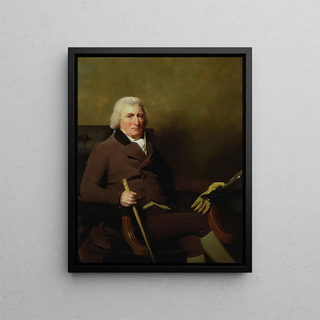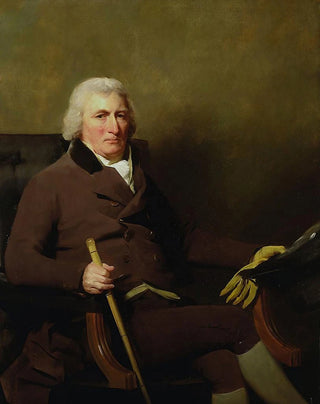Art print | Portrait of Sir Patrick Inglis, Baronet of Sunnyside - Sir Henry Raeburn


View from behind

Frame (optional)
The "Portrait of Sir Patrick Inglis, Baronet of Sunnyside" is an iconic work by the Scottish painter Sir Henry Raeburn, who masterfully captures the very essence of his subjects. This canvas, created in the early 19th century, not only demonstrates the artist's talent but also highlights the significance of portraiture in British society of that era. Sir Patrick Inglis, a figure of Scottish nobility, is depicted with a dignity and presence that transcend mere artistic exercise to become a true historical testament. Through this artwork, Raeburn invites us to explore the nuances of his model's personality while offering a fascinating glimpse into the aristocracy of his time.
Style and uniqueness of the work
Raeburn's style is characterized by a realistic approach and meticulous attention to detail, which are evident in every brushstroke of this portrait. The artist employs a palette of rich, deep colors, creating a warm and intimate atmosphere. Sir Patrick Inglis's face is illuminated by a soft light, emphasizing the striking features of his face, while subtly placed shadows add depth and dimension to the overall composition. The confident posture of the baronet, combined with his direct and engaging gaze, establishes an immediate connection with the viewer, making the work all the more captivating. Raeburn manages to balance the formality of the portrait with a touch of liveliness, offering a representation that feels both frozen in time and vibrantly alive.
The artist and his influence
Sir Henry Raeburn, considered the most important portraitist of his time in Scotland, established his reputation through his unique style and his ability to translate the soul of his subjects onto the canvas. Trained at the school of European masters, he integrated elements of neoclassicism while developing a personal approach that was entirely his own. Raeburn's portraits do not merely depict individuals; they tell stories, evoke emotions, and reveal facets of life.

Matte finish

View from behind

Frame (optional)
The "Portrait of Sir Patrick Inglis, Baronet of Sunnyside" is an iconic work by the Scottish painter Sir Henry Raeburn, who masterfully captures the very essence of his subjects. This canvas, created in the early 19th century, not only demonstrates the artist's talent but also highlights the significance of portraiture in British society of that era. Sir Patrick Inglis, a figure of Scottish nobility, is depicted with a dignity and presence that transcend mere artistic exercise to become a true historical testament. Through this artwork, Raeburn invites us to explore the nuances of his model's personality while offering a fascinating glimpse into the aristocracy of his time.
Style and uniqueness of the work
Raeburn's style is characterized by a realistic approach and meticulous attention to detail, which are evident in every brushstroke of this portrait. The artist employs a palette of rich, deep colors, creating a warm and intimate atmosphere. Sir Patrick Inglis's face is illuminated by a soft light, emphasizing the striking features of his face, while subtly placed shadows add depth and dimension to the overall composition. The confident posture of the baronet, combined with his direct and engaging gaze, establishes an immediate connection with the viewer, making the work all the more captivating. Raeburn manages to balance the formality of the portrait with a touch of liveliness, offering a representation that feels both frozen in time and vibrantly alive.
The artist and his influence
Sir Henry Raeburn, considered the most important portraitist of his time in Scotland, established his reputation through his unique style and his ability to translate the soul of his subjects onto the canvas. Trained at the school of European masters, he integrated elements of neoclassicism while developing a personal approach that was entirely his own. Raeburn's portraits do not merely depict individuals; they tell stories, evoke emotions, and reveal facets of life.






